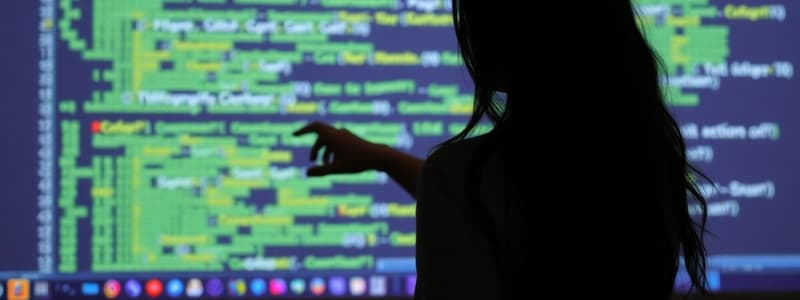Podcast
Questions and Answers
What is the primary focus of computer science?
What is the primary focus of computer science?
- The study of computation and information. (correct)
- The study of the human body.
- The analysis of economic systems.
- The design of buildings.
Which area focuses on the mathematical foundations of computer science?
Which area focuses on the mathematical foundations of computer science?
- Artificial Intelligence
- Theoretical Computer Science (correct)
- Computer Architecture
- Software Engineering
What is an algorithm?
What is an algorithm?
- A programming language.
- A type of computer hardware.
- A step-by-step procedure for solving a problem. (correct)
- A method of data storage.
Which of the following is a key aspect of computer architecture?
Which of the following is a key aspect of computer architecture?
What is the role of a compiler?
What is the role of a compiler?
Which of these activities is part of software engineering?
Which of these activities is part of software engineering?
What does artificial intelligence primarily involve?
What does artificial intelligence primarily involve?
What is the purpose of a database?
What is the purpose of a database?
Which concept is central to computer networks?
Which concept is central to computer networks?
What is the main function of an operating system?
What is the main function of an operating system?
Flashcards
Programming Language
Programming Language
A notation for writing computer programs which allow humans to communicate instructions to computers.
Algorithm
Algorithm
Step-by-step procedure for solving a problem.
Computer Architecture
Computer Architecture
Deals with the design and organization of computer systems, focusing on hardware and software interaction.
Data Structures
Data Structures
Signup and view all the flashcards
Software Engineering
Software Engineering
Signup and view all the flashcards
Artificial Intelligence (AI)
Artificial Intelligence (AI)
Signup and view all the flashcards
Databases
Databases
Signup and view all the flashcards
Operating Systems
Operating Systems
Signup and view all the flashcards
Computer Security
Computer Security
Signup and view all the flashcards
Computer Ethics
Computer Ethics
Signup and view all the flashcards
Study Notes
- Computer science is the study of computation and information.
- It deals with theory, experimentation, and engineering to design and use computers.
- It involves the study of algorithms, data structures, and computer architecture.
- It also covers programming languages, software engineering, and artificial intelligence.
Theoretical Computer Science
- Focuses on the mathematical aspects of computer science.
- Includes the study of algorithms, data structures, and complexity theory.
- Computability theory defines what problems can be solved by computers.
- Complexity theory classifies problems based on how much time or space they require to solve.
- Information theory quantifies the amount of information.
- Automata theory deals with abstract machines and their computational power.
Algorithms and Data Structures
- An algorithm is a step-by-step procedure for solving a problem.
- Data structures are ways of organizing and storing data.
- Efficiency is a major consideration in algorithm design.
- Common algorithm design paradigms include divide-and-conquer, dynamic programming, and greedy algorithms.
- Important data structures include arrays, linked lists, trees, graphs, and hash tables.
Computer Architecture
- Deals with the design and organization of computer systems.
- Covers topics such as CPU design, memory systems, and input/output devices.
- Computer architecture focuses on how hardware and software interact.
- Parallel processing and distributed systems are also part of computer architecture.
Programming Languages
- A programming language is a notation for writing computer programs.
- Programming languages allow humans to communicate instructions to computers.
- Different programming paradigms include imperative, object-oriented, functional, and logical programming.
- Compilers translate high-level language (source code) to a lower-level language (machine code).
- Interpreters directly execute the source code.
Software Engineering
- Concerned with the development and maintenance of software systems.
- Software engineering involves requirements analysis, design, coding, testing, and deployment.
- Software development methodologies include waterfall, agile, and DevOps.
- Quality assurance is a critical aspect of software engineering.
Artificial Intelligence
- The study and design of intelligent agents.
- AI includes machine learning, natural language processing, computer vision, and robotics.
- Machine learning algorithms learn from data to make predictions or decisions.
- Natural language processing enables computers to understand and generate human language.
- Computer vision allows computers to "see" and interpret images.
- Robotics deals with the design, construction, operation, and application of robots.
Databases
- Organized collections of structured information, or data, typically stored electronically in a computer system.
- Databases are controlled by a database management system (DBMS).
- Relational databases organize data into tables with rows and columns.
- NoSQL databases provide flexible schema designs and scale horizontally.
- Database design involves defining the structure and organization of data.
- Query languages, such as SQL, are used to retrieve and manipulate data.
Computer Networks
- Deals with the communication between computers.
- Covers topics such as network protocols, network topologies, and network security.
- The Internet is a global network of interconnected computer networks.
- Network protocols, such as TCP/IP, define how data is transmitted over networks.
- Network security involves protecting networks from unauthorized access and cyber threats.
Operating Systems
- Manages computer hardware and software resources.
- Provides services such as process management, memory management, and file system management.
- Operating systems act as an intermediary between applications and hardware.
- Popular operating systems include Windows, macOS, and Linux.
- Real-time operating systems (RTOS) are used in embedded systems.
Graphics and Visualization
- Deals with the creation and manipulation of visual images.
- Computer graphics is used in many applications, including gaming, animation, and simulation.
- Visualization transforms data into visual representations.
- Graphics hardware, such as GPUs, accelerates graphics rendering.
Human-Computer Interaction (HCI)
- Studies the design and evaluation of user interfaces.
- HCI aims to make computer systems usable, efficient, and enjoyable.
- User interface design involves creating interactive and intuitive interfaces.
- Usability testing evaluates the effectiveness of user interfaces.
Parallel and Distributed Computing
- Parallel computing uses multiple processors to solve a problem concurrently.
- Distributed computing uses multiple computers to solve a problem collaboratively.
- Parallel and distributed computing enables faster problem solving and scalability.
- Cloud computing is a form of distributed computing that provides on-demand access to resources.
Security and Cryptography
- Computer security protects computer systems from threats.
- Cryptography provides techniques for secure communication.
- Encryption algorithms transform data into an unreadable format.
- Authentication verifies the identity of users.
- Firewalls and intrusion detection systems protect networks from unauthorized access.
Simulation and Modeling
- Involves creating models of real-world systems.
- Simulations are used to study the behavior of systems.
- Modeling techniques include mathematical models, agent-based models, and discrete event simulation.
Computer Ethics
- Examines the ethical implications of computer technology.
- Issues such as privacy, intellectual property, and cybercrime are considered.
- Computer ethics provides guidelines for responsible use of technology.
Studying That Suits You
Use AI to generate personalized quizzes and flashcards to suit your learning preferences.




